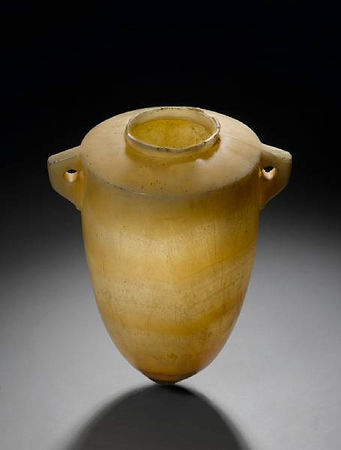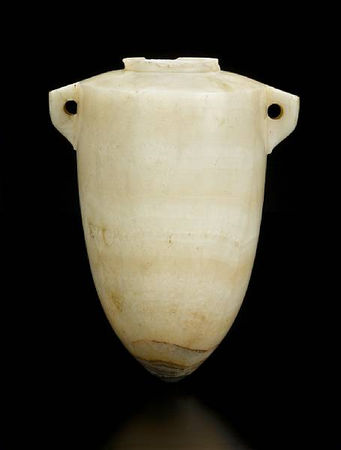An Egyptian alabaster torpedo vase. Third Intermediate Period, 22nd-23rd Dynasty, circa 9th-8th Century B.C.
An Egyptian alabaster torpedo vase. Third Intermediate Period, 22nd-23rd Dynasty, circa 9th-8th Century B.C.
Of pale translucent banded alabaster, polished, with darker bands of amber and grey towards the pointed base, the torpedo shaped body with upward curving sides and a short downward sloping shoulder, extending at each side into the sloping, pierced, lug handles with small spurs beneath, the short circular neck with a flattened rim and interior tooled band, 16½in (42cm) high, tip of base restored, rim chipped, mounted. Sold for £36,000
Published: Prof. Martin Almagro Basch, Separata II, 'Un Nuevo Vaso Egipcio de Alabaastro en España' by Maria del Carmen Perez Die, (Ministerio de Cultura, Madrid 1983), p.237-244.
Provenance: Property of the Marqués de Fontalba, D. Luis Arcos Carvajal, Madrid, Spain; the vase has been passed down through the family's estate the finca 'El Retiro', near Churriana in southern Spain, over the last 250 years. The vase was rediscovered at the family estate, the finca 'El Retiro' in 1910, while work was being carried out there, along with an Egyptian alabaster lidded canopic jar. The canopic jar was gifted to the Archaeological Museum of Madrid where it remains today, and this torpedo vase remained in the family.
Although both vases appear to have come from the finca it is unclear how they originally came to be there. There are early references to the vases, in books and publications relating to the family and the finca back to the 18th Century. In a publication by Antonio Ponz in 1794, he refers to the finca 'El Retiro', passing into the possession of the 7th Count of Villalcazar, D. Juan Felipe Longinos de Echeverry in 1754. In 1814 there is a document addressed to the Count, which refers to him owning a canopic jar and four 'urnas cinericias'. We know from the parallels listed below, that similar vases have been found in Spain due to its Phoenician colonization, so it is possible that the vases were brought over by the Phoenicians to the Churriana area and were found in the grounds of the finca. Another possibilty is that the Count, a known lover of the arts, purchased them and brought them back to the finca, this is perhaps supported by the evidence that the garden was once filled with Antiquities. Unfortunately, so far no documents have been found that tell us where the Count acquired them, access to the library at the finca has not been possible and in addition many documents were burned during the Spanish Civil war.
The publication is particularly helpful, as it discusses the various parallel vases found both inside and outside Spain. Although not identical, the closest example was found in Cadiz at the Puerto de Santa Maria, and is inscribed with hieroglyphs for the owner. Gamer-Wallert dated this piece to the 22nd Dynasty, saying it was probably made in Thebes in Egypt for an Egyptian tomb and is likely to be in the Archaeological Museum in Cadiz. Two other vases were found in the Necropolis 'Laurita del Cerro de San Cristóbal en Almunecar', both are torpedo shaped but without handles, one has a Phoenician inscription and both were probably manufactured in Egypt in the 9th-8th Centuries B.C. There is also an example in Egypt, from the Royal Necropolis in Tanis found in the tomb of Takelot II, inscribed with the cartouche of Osorkon I (924-889 B.C., 22nd Dynasty). Others have been discovered in the Near East, for instance the example in the Staaliche Museum in Berlin found by Walter Andrae in Asur which has an inscription to Takelot, identified as a reference to Takelot II (754-734 B.C.), by Gamer-Wallert; and another alabaster jar was found by Max Mallowan in the North-East Palace at Nimrud which also bears a hieroglyphic inscription.
Accompanied by a copy of its publication in the journal by Prof. Basch, 1983 and its export licence issued in June 2008 by the Ministerio de Cultura.
Literature: Cf. I. Gamer-Wallert, Ägyptische und ägyptisierende Funde von der Iberischen Halbinsel, (Weisbaden 1978), pls. 22-24.
(Copyright © 2002-2008 Bonhams 1793 Ltd., Images and Text All Rights Reserved)
Bonhams. Antiquities. New Bond Street, 15 Oct 2008. www.bonhams.com

/https%3A%2F%2Fprofilepics.canalblog.com%2Fprofilepics%2F1%2F0%2F100183.jpg)
/https%3A%2F%2Fstorage.canalblog.com%2F03%2F02%2F119589%2F96711876_o.jpg)
/https%3A%2F%2Fstorage.canalblog.com%2F11%2F31%2F119589%2F94773502_o.jpg)
/https%3A%2F%2Fstorage.canalblog.com%2F20%2F83%2F119589%2F94772815_o.jpg)
/https%3A%2F%2Fstorage.canalblog.com%2F26%2F72%2F119589%2F75604929_o.jpg)
/https%3A%2F%2Fstorage.canalblog.com%2F59%2F60%2F119589%2F26458628_o.jpg)





/http%3A%2F%2Fstorage.canalblog.com%2F47%2F82%2F119589%2F127772016_o.jpg)
/http%3A%2F%2Fstorage.canalblog.com%2F46%2F16%2F119589%2F122392028_o.jpg)
/http%3A%2F%2Fstorage.canalblog.com%2F20%2F19%2F119589%2F120625079_o.jpeg)
/http%3A%2F%2Fstorage.canalblog.com%2F20%2F86%2F119589%2F120616936_o.jpg)